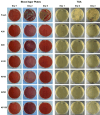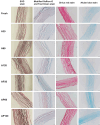75% ethanol disinfection preserves biocompatibility and mechanical properties of swim bladder for cardiovascular applications
- PMID: 40535650
- PMCID: PMC12170429
- DOI: 10.62347/OVKI5914
75% ethanol disinfection preserves biocompatibility and mechanical properties of swim bladder for cardiovascular applications
Abstract
Objectives: To evaluate the effects of 75% ethanol on the disinfection efficacy, biocompatibility, extracellular matrix (ECM) integrity, and mechanical properties of swim bladders from Hypophthalmichthys nobilis, a promising biomaterial for cardiovascular applications.
Methods: Swim bladders were immersed in 75% ethanol for 30, 60, or 120 minutes, followed by phosphate-buffered saline (PBS) rinsing. Disinfection efficacy was assessed using bacterial cultures; cytotoxicity and blood compatibility were evaluated using CCK-8 assays and hemolysis tests. The decellularization efficiency, ECM integrity, and mechanical properties were analyzed through histological staining, DNA quantification, and uniaxial tensile test.
Results: 75% ethanol effectively disinfected the swim bladder with minimal cytotoxicity and good hemocompatibility. Histological staining demonstrated preservation of collagen fibers, elastin, and glycosaminoglycans (GAGs), indicating minimal impact on the ECM structure. The uniaxial tensile test revealed that ethanol immersion caused tissue dehydration and increased stiffness, but these effects were reversible after PBS rinsing, with mechanical properties returning to baseline. DNA content and tissue thickness normalized following PBS washing, suggesting that ethanol did not impair decellularization.
Conclusions: 75% ethanol is an effective disinfectant for swim bladder biomaterials, preserving biocompatibility, ECM structure, and mechanical properties after rinsing. These findings support the use of swim bladder-derived scaffolds in cardiovascular tissue engineering applications.
Keywords: Swim bladder; ethanol; extracellular matrix; hemocompatibility; mechanical properties.
AJTR Copyright © 2025.
Conflict of interest statement
None.
Figures






Similar articles
-
Return to Running After Achilles Tendon Repair: How Do US Navy Service Members' Physical Readiness Tests Change After Undergoing an Achilles Tendon Repair?Clin Orthop Relat Res. 2025 Jun 18. doi: 10.1097/CORR.0000000000003590. Online ahead of print. Clin Orthop Relat Res. 2025. PMID: 40536551
-
Development of the active ingredient composition of hand antiseptics in Germany from 2004 to 2022 with special consideration of ethanol as active agent.GMS Hyg Infect Control. 2025 May 2;20:Doc17. doi: 10.3205/dgkh000546. eCollection 2025. GMS Hyg Infect Control. 2025. PMID: 40529471 Free PMC article.
-
Prediction, screening and characterization of novel bioactive tetrapeptide matrikines for skin rejuvenation.Br J Dermatol. 2024 Jun 20;191(1):92-106. doi: 10.1093/bjd/ljae061. Br J Dermatol. 2024. PMID: 38375775
-
A bibliometric analysis of research trends in mesenchymal stem cell therapy for neonatal bronchopulmonary dysplasia: 2004-2024.Front Pediatr. 2025 Jun 3;13:1558301. doi: 10.3389/fped.2025.1558301. eCollection 2025. Front Pediatr. 2025. PMID: 40530182 Free PMC article. Review.
-
Mechanical harvesting of cell sheets: an efficient approach for bone and cartilage tissue engineering.Stem Cell Res Ther. 2025 Jun 17;16(1):310. doi: 10.1186/s13287-025-04411-5. Stem Cell Res Ther. 2025. PMID: 40528269 Free PMC article. Review.
References
LinkOut - more resources
Full Text Sources
